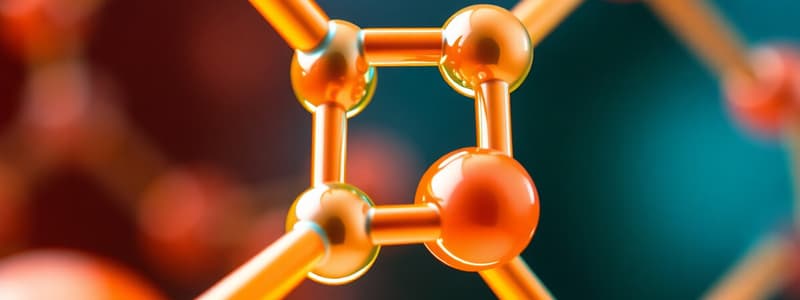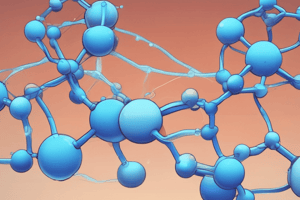Podcast
Questions and Answers
What is the special case of dipole-dipole interaction that involves hydrogen called?
What is the special case of dipole-dipole interaction that involves hydrogen called?
- Hydrogen bond (correct)
- Induced dipole interaction
- Permanent dipole interaction
- London dispersion effect
Which of the following factors contributes to the weak interactions found in molecular solids?
Which of the following factors contributes to the weak interactions found in molecular solids?
- Electrostatic attraction between ions
- Covalent bonding between atoms
- Hydrodynamic forces in liquids
- Interactions between instantaneous dipoles (correct)
What is an example of a molecule that can be classified as a linear alkane?
What is an example of a molecule that can be classified as a linear alkane?
- Ethylene (C2H4)
- Propane (C3H8) (correct)
- Phenol (C6H5OH)
- Acetic acid (C2H4O2)
What is the upper limit temperature at which molecular solids will typically remain solid?
What is the upper limit temperature at which molecular solids will typically remain solid?
What defines the equilibrium spacing between atoms in a solid?
What defines the equilibrium spacing between atoms in a solid?
Which arrangement of atoms in solids is referred to as crystalline?
Which arrangement of atoms in solids is referred to as crystalline?
Which conditions are required for the formation of a hydrogen bond?
Which conditions are required for the formation of a hydrogen bond?
What mechanism is primarily responsible for the freezing behavior of water at low temperatures?
What mechanism is primarily responsible for the freezing behavior of water at low temperatures?
Which type of solid is characterized by directional bonds that emphasize the tetrahedral arrangement of atoms?
Which type of solid is characterized by directional bonds that emphasize the tetrahedral arrangement of atoms?
What primarily distinguishes ionic solids from metallic solids in bulk formations?
What primarily distinguishes ionic solids from metallic solids in bulk formations?
Which of the following statements about bond energies is correct?
Which of the following statements about bond energies is correct?
How do secondary bonds compare to covalent bonds in terms of interaction strength?
How do secondary bonds compare to covalent bonds in terms of interaction strength?
What structural feature characterizes ionic solids like sodium chloride?
What structural feature characterizes ionic solids like sodium chloride?
Which type of bonding allows for the formation of electric dipoles?
Which type of bonding allows for the formation of electric dipoles?
In terms of stability, which bond type typically allows for the formation of highly stable molecules?
In terms of stability, which bond type typically allows for the formation of highly stable molecules?
What best describes the primary consequence of the arrangement of atoms in a material?
What best describes the primary consequence of the arrangement of atoms in a material?
Which solid is least likely to exhibit directional bonding?
Which solid is least likely to exhibit directional bonding?
Which state of matter allows for the most movement of atoms or molecules?
Which state of matter allows for the most movement of atoms or molecules?
What is the result of one end of a molecule possessing a slight positive charge while the other end is slightly negative?
What is the result of one end of a molecule possessing a slight positive charge while the other end is slightly negative?
What is the minimum energy condition related to atomic interactions?
What is the minimum energy condition related to atomic interactions?
Which of the following materials is typically not formed from ionic substances?
Which of the following materials is typically not formed from ionic substances?
What happens to the total energy of two atoms when they approach each other?
What happens to the total energy of two atoms when they approach each other?
What parameter is critical for bond formation between atoms?
What parameter is critical for bond formation between atoms?
Which statement accurately describes covalent bonds?
Which statement accurately describes covalent bonds?
In the context of energy-separation diagrams, what does repulsion between atomic nuclei indicate?
In the context of energy-separation diagrams, what does repulsion between atomic nuclei indicate?
What is the packing factor for body-centered cubic (BCC) structures?
What is the packing factor for body-centered cubic (BCC) structures?
Which of the following correctly identifies a component of natural composites?
Which of the following correctly identifies a component of natural composites?
Which statement about face-centered cubic (FCC) structures is true?
Which statement about face-centered cubic (FCC) structures is true?
Which of the following is an example of a synthetic composite?
Which of the following is an example of a synthetic composite?
What is the primary characteristic of cermets?
What is the primary characteristic of cermets?
How are composites defined in the context of materials science?
How are composites defined in the context of materials science?
Which composite is NOT mentioned as a synthetic composite?
Which composite is NOT mentioned as a synthetic composite?
What is the packing factor of face-centered cubic (FCC) structures?
What is the packing factor of face-centered cubic (FCC) structures?
Which of the following represents a natural composite material?
Which of the following represents a natural composite material?
What is the packing factor for a simple cubic structure?
What is the packing factor for a simple cubic structure?
In a simple cubic structure, how much of each atom's volume contributes to the structural cell?
In a simple cubic structure, how much of each atom's volume contributes to the structural cell?
Which of the following structures has the highest packing factor?
Which of the following structures has the highest packing factor?
What is the volume of the structural cell for a cube with a side length of 2a?
What is the volume of the structural cell for a cube with a side length of 2a?
What percentage of space within a simple cubic structure is empty?
What percentage of space within a simple cubic structure is empty?
Which type of bonding characterizes ceramics?
Which type of bonding characterizes ceramics?
What is the main characteristic of materials categorized as amorphous?
What is the main characteristic of materials categorized as amorphous?
Which solid structure allows smaller atoms to occupy gaps without disturbing the arrangement?
Which solid structure allows smaller atoms to occupy gaps without disturbing the arrangement?
Which of the following statements about the simple cubic structure is true?
Which of the following statements about the simple cubic structure is true?
Flashcards
Dipole-dipole interaction
Dipole-dipole interaction
The force of attraction between two molecules due to the interaction of their permanent dipoles.
Hydrogen bond
Hydrogen bond
A type of dipole-dipole interaction where a hydrogen atom bonded to a highly electronegative atom is attracted to the electron cloud of another electronegative atom.
London dispersion force
London dispersion force
The weakest type of intermolecular force arising from temporary fluctuations in electron distribution around molecules.
Molecular solids
Molecular solids
Signup and view all the flashcards
Interatomic spacing
Interatomic spacing
Signup and view all the flashcards
Crystalline structure
Crystalline structure
Signup and view all the flashcards
Close-packed arrangement
Close-packed arrangement
Signup and view all the flashcards
Linear alkanes
Linear alkanes
Signup and view all the flashcards
Body-Centered Cubic (BCC)
Body-Centered Cubic (BCC)
Signup and view all the flashcards
Face-Centered Cubic (FCC)
Face-Centered Cubic (FCC)
Signup and view all the flashcards
Packing Factor
Packing Factor
Signup and view all the flashcards
Composite Materials
Composite Materials
Signup and view all the flashcards
Bone and Dentin
Bone and Dentin
Signup and view all the flashcards
Synthetic Composites
Synthetic Composites
Signup and view all the flashcards
Composite Restorative Material
Composite Restorative Material
Signup and view all the flashcards
Cermet
Cermet
Signup and view all the flashcards
Glass-Ionomer Cement
Glass-Ionomer Cement
Signup and view all the flashcards
Interatomic Bonding
Interatomic Bonding
Signup and view all the flashcards
Bond energy
Bond energy
Signup and view all the flashcards
Covalent bond
Covalent bond
Signup and view all the flashcards
Ionic bond
Ionic bond
Signup and view all the flashcards
Metallic bond
Metallic bond
Signup and view all the flashcards
Ionic solid
Ionic solid
Signup and view all the flashcards
Metallic solid
Metallic solid
Signup and view all the flashcards
Covalent solid
Covalent solid
Signup and view all the flashcards
van der Waals bond
van der Waals bond
Signup and view all the flashcards
Electric dipole
Electric dipole
Signup and view all the flashcards
Ceramics and glasses
Ceramics and glasses
Signup and view all the flashcards
Primary Bond
Primary Bond
Signup and view all the flashcards
Gas
Gas
Signup and view all the flashcards
Liquid
Liquid
Signup and view all the flashcards
Solid
Solid
Signup and view all the flashcards
Energy-Separation Diagram
Energy-Separation Diagram
Signup and view all the flashcards
Minimum Energy (Em)
Minimum Energy (Em)
Signup and view all the flashcards
Crystalline Solid
Crystalline Solid
Signup and view all the flashcards
Amorphous Solid
Amorphous Solid
Signup and view all the flashcards
Structural Cell
Structural Cell
Signup and view all the flashcards
Simple Cubic Structure
Simple Cubic Structure
Signup and view all the flashcards
Study Notes
Introduction
- All materials are built from atoms
- There is a relationship between the atomic structure and the properties of a material
- The arrangement of atoms in a solid affects its properties
- Atoms combine to determine the microscopic structure of a solid
Joining Atoms Together
- When two atoms are brought together, they may link to form a molecule
- Any bonds that form are called primary bonds
- The degree of interaction between atoms depends on the type of bond forming
- Three main phases of matter: solids, liquids, gases
- Solids have their own distinct structure and associated properties
- In solids, the movement of atoms is limited to local vibration
Types of Primary Bonds
- There are three types of primary bonds: covalent, ionic, and metallic
Covalent Bonds
- The bond is the simplest and strongest
- Atoms share electrons to achieve an inert gas configuration
- The electrons are shared equally or unequally depending on the electronegativity of the atoms forming the bond
- Covalent bonds usually form between similar elements
Ionic Bonds
- Formed when an electron is transferred from one atom to another
- The positively charged ion is attracted to the negatively charged ion
- The electrostatic force holds the ions together
- Formed between dissimilar elements
Metallic Bonds
- The atoms in a metallic solid are held together by a cloud of electrons
- The electrons move freely among the atoms, creating a strong bond
- Usually formed between similar elements
- The electrons are delocalized
Secondary Bonding
- Occurs when two or more atoms share electrons
- Creates weak bonds called van der Waals forces
- Molecules can interact with one another
- Occur due to the numerous dipole-dipole interactions between molecules
Studying That Suits You
Use AI to generate personalized quizzes and flashcards to suit your learning preferences.




